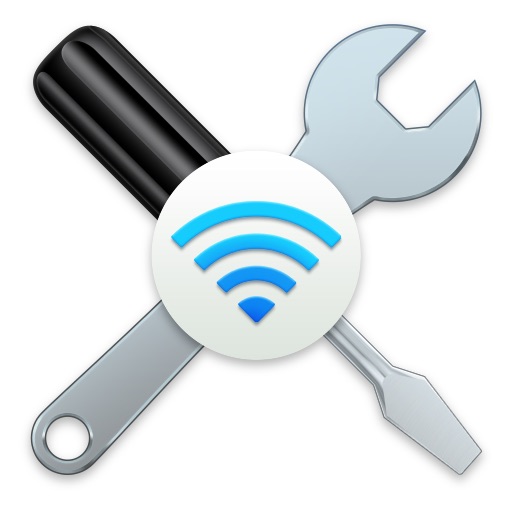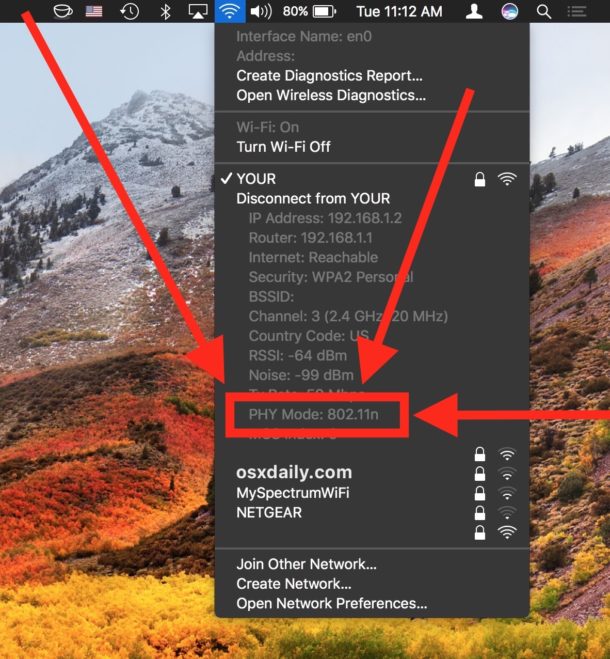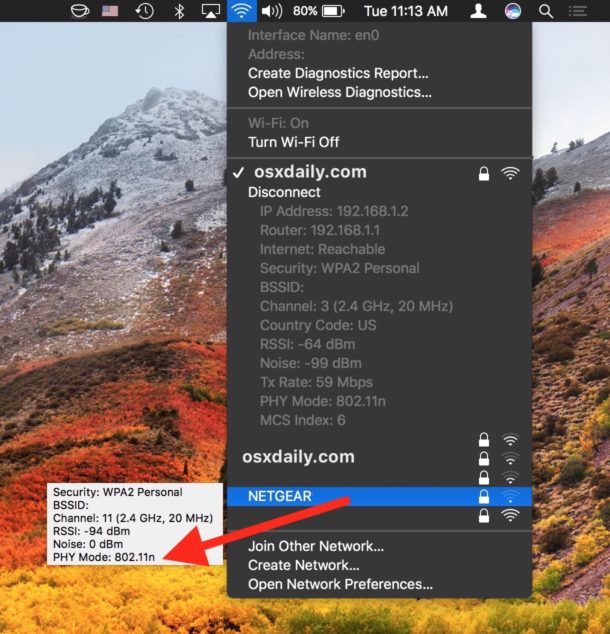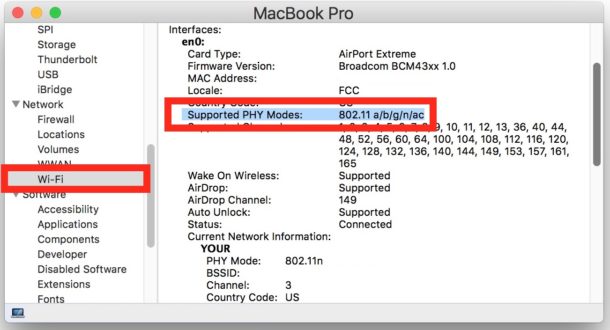How to Tell if Mac is Using 802.11ac, 802.11n or Other Wi-Fi Protocol

Most users connect a Mac to a wi-fi network and don’t think too much about which 802.11 wi-fi band protocol is in use, but many advanced users and network administrators do want to know which 802.11 wireless standard is in use. Typically someone would want to know which wi-fi PHY standard is in use to insure speed optimization and coverage range, as each wireless standard is different, with differing ranges and offering different WLAN connection speeds.
This article will show you how to determine if a Mac is currently using 802.11a, 802.11b, 802.11g, 802.11n, or 802.11ac to connect to a particular router. Additionally, we’ll show you how to check which wifi modes a Mac wireless card supports, and also show you how to check which version protocol of 802.11 is in use on other nearby routers.
The simplest way to determine the 802.11 protocol of a network is to reveal the hidden advanced wi-fi details from within the wireless menu in Mac OS, where you will find band PHY mode and other information. The following tips work the same on virtually every vaguely modern version of Mac OS and Mac OS X.
How to Determine What Wi-Fi Protocol Standard a Mac Is Currently Using
You can check which wireless protocol is currently in use on just about every modern Mac as long as it has a wi-fi NIC that is actively in use. Here’s all you need to do:
- Hold down the OPTION key and then click on the Wi-Fi icon in the Mac menu bar
- Find the currently connected wireless router and then look for the “PHY Mode” item in the menu to see the

In the example here, the current router is using the 802.11n protocol, as you can see the protocol next to “PHY Mode” (For the curious, PHY is short for physical layer, referring to the lowest level of the OSI communications model).
Depending on your router and the Mac network card, you may see 802.11a, 802.11ac, 802.11b, 802.11n, 802.11g, or perhaps another variation like 802.11ay or az if you’re living in an electrical engineer WLAN lab or somewhere in the future.
You can also determine what wireless security encryption method is in use with this same trick.
How to Check Other Router Wi-Fi Modes from a Mac
You can also determine what other wifi modes are in use with other nearby routers if they are in range, even if the Mac is not connected to them.
- Hold down the OPTION key and then click on the Wi-Fi icon in the Mac menu bar
- Hover the mouse cursor over another wireless network SSID name for a moment to reveal the wi-fi mode available for that router, again looking for “PHY Mode”

This trick can be particularly helpful if your router is dual-band (or greater) and you want to know which 802.11 protocol the SSID is using before connecting to it. For example, some routers may broadcast multiple networks, say an 802.11ac along with an 802.11g, but you might want to connect only to the 802.11ac broadcast.
How to Determine What Wi-Fi PHY Protocols a Mac Supports
Of course you might also want to know what WLAN modes and protocols your Mac wi-fi card actually supports and what it can connect to. This will let you know if a Mac WLAN NIC is compatible with a particular wifi mode. Fortunately Mac OS stores these details within the System Information app.
- Hold down the Option key and click on the Apple menu
- Choose “System Information”
- Select “Network” from the left side list of system details, then browse the interfaces list to find “Supported PHY Modes” for the active wireless network card

You will see something like “Supported PHY Modes: 802.11 a/b/g/n/ac” which indicates each of those 802.11 protocols is available for that particular wireless card to use.
Those interested can read more about IEEE 802.11 standards here, it’s technical, geeky and likely not particularly relevant to average users, but if you like to know how the sausage is made or what the limitations are for particular WLAN modes, you may find it interesting.
Do you know of any other interesting tips or tidbits regarding a Mac and compatible WLAN modes, protocols, and standards? Share with us in the comments!


Well, reading the maybe in some WLan engineer lab or in the future sentence made me laugh. Though unfortunately you guessed the wrong one, after ac came ax. ay / az seem to be still in the future and the next standard is apparently be (aka Wifi 7).
Awesome article, completely forgot about trying Option on the wifi menu. (Even though that’s the magic key to who cool thing on menus)
What about getting this data from the iPhone or iPad?
Yeah well you get a thumbs up for this article. Way to bawl out of control. Good job. Stay awesome.
once connected I have 802.11ac however as is pointed out my network when connects is doing via 802.11n. is there a way to tweak on the Mac to only connect via 802.11ac ? thanks
Is there a way to display this information in Terminal? It’d be cool to display it as a Geeklet (GeekTool)
Wow, this is a great trick. Now that I see mine is using 802.11n and I know it supports ac, and the Apple Time Capsule that it connects to also supports ac, how do I make it connect using ac? It’s only about 15 feet away.
can you show simple way to print these articles which one would want to save without having the ads involved in the printing
thanks
This is a great question Chris! The best way to print a simplified version of any article o web page (ours included) is to put them into Safari Reader mode first, and then print from there.
In Safari, you can enter Reader mode through the “View” menu by choosing “Show Reader”
Once you are in Reader mode you will notice the article has a simplified appearance without any other logos, sidebars, ads, links, or anything unrelated to the core article itself.
Then, go to print as usual, from the “File” menu choose “Print” and select your printer.
Hope that helps, cheers!
— Paul
Thanks; this is a good tip; helpful to me. I see my neighbor is using the same channel as my main network. I’ll change the channel and see if that improves my network performance.
This was really cool. Now if only I knew what it meant to 802.11.ac. 🤔
https://www.extremetech.com/computing/160837-what-is-802-11ac-and-how-much-faster-than-802-11n-is-it
It is nice to know how to check this quickly.
I have found that 802.11ac is quite good and is not only fast but has a long range, whereas 802.11n seems to have a weaker signal. My network broadcasts both with dual access points for compatibility I suppose, but I always try to connect to the 802.11ac access point for maximum speeds.
If your Mac supports 802.11ac you should try to use it, it’s very fast for local file transfers and great if you have fiber internet too.